Ventilation in the window sill: methods and detailed instructions for arranging window sill ventilation
You can solve such a common problem of “crying” windows in literally a couple of hours, because often the cause of condensation is insufficient air exchange due to too wide window sills. Additional ventilation into the window sill is the main way to correct the direction of the flow of hot air coming from the heating radiator and let it flow to the double-glazed window.
With proper circulation of air masses and ventilation of the room, owners of plastic windows will be able to forget about excessive humidity, annoying puddles on the windowsill and harmful fungus. But what is such ventilation and how to arrange it correctly?
In this material we will look at the principle of operation of a window sill ventilation system with a supply valve, talk about the types of ventilation grilles and how to install them in plastic or wooden window sills.
The content of the article:
The need to install ventilation in the window sill
Of course, high-quality plastic windows have many advantages over old wooden frames. The modern design provides excellent sound insulation, retains heat in the home, protects against drafts and is easier to maintain. However, the advantages of ergonomic window systems also contain their disadvantages.
Tightness and a complete lack of natural ventilation often lead to the formation of condensation on a double-glazed window, even in a correctly installed window.The cold, damp surface of plastic becomes an excellent environment for mold to grow.
Sealed double-glazed windows and reliable seals prevent heat loss as much as possible. However, along with the heat, excess steam, carbon dioxide and carbon monoxide remain in the apartment. Old-style wooden frames made it possible to partially release air from the home even without ventilation. Modern window systems, the frames of which do not have an inlet channel, do not have such abilities.

The main reason for installing an additional ventilation system in the window sill is to try to get rid of condensation. The glass unit remains cold due to the low temperature; after contact with warm air masses, microdrops of moisture are formed on its surface, which can turn into real streams. Therefore, it is necessary to take timely measures to get rid of excess humidity in the room.
However, if the air flow from the battery passes fully near the surface of the glass, condensation simply will not have time to form. And even short ventilation of the room will ensure good air exchange: heavy apartment air with unwanted impurities will leave the room, being replaced by fresh street air.
The correct direction of the flow of warm air from the battery and periodic opening of the sash or installation supply valve on the window will relieve homeowners from high humidity in the apartment and from condensation settling on the glass.
Window sill ventilation methods
Depending on the initial depth of the window sill, the thickness of the external wall and the seating depth of the window frame, air circulation around the glass unit can be ensured in two ways:
- using the natural passage of flows through holes made in the window sill for ventilation;
- thanks to the installation of a separate ventilation duct with a supply valve.
Each method has its own characteristics both in the selection of materials and in implementation.
Ventilation through grill openings
The first method of improving air passage is quite simple and does not require special skills.
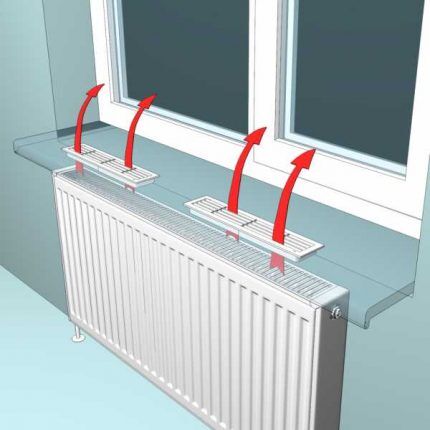
Even an inexperienced craftsman can make the necessary holes and secure the ventilation grille. The method is suitable for window sills of medium and large depth, the protruding part of which significantly overlaps the heating radiator. Ventilation grilles will allow air to pass through the window sill more freely and reach the glass unit in sufficient quantities.
The grilles themselves can be made of different materials: plastic, aluminum, steel and even wood. The most ergonomic are metal products coated with special paint that is resistant to high temperatures. Plastic is no less common on sale, but this material can become deformed over time and lose its original shade, which also does not add aesthetics to it after a year of use.
The dimensions of the ventilation grille are selected based on the width of the window sill. To make the window warm up more evenly, it is better to install the grill along the entire window sill.Particular attention should be paid to the live cross-section of the grille - the size of the holes through which air will pass. The larger their area, the more efficient the circulation will be.
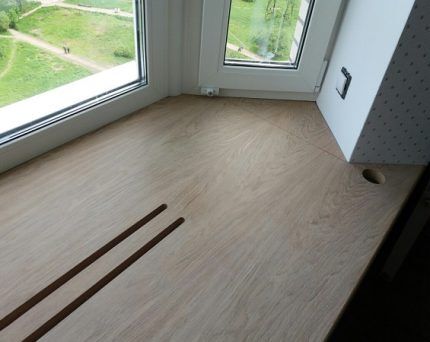
The slats themselves can be static or adjustable. The second option is more preferable for installation, as it allows you to more accurately adjust the air direction angle or completely block the air exchange.
Installation of a channel with a supply valve
A more complex method that requires more skill during installation and knowledge to select a special complex - a window sill valve.
The method consists in arranging a special window sill ventilation system, which consists of:
- inner box with bars, through which exhaust air is taken in;
- ventilation duct in the form of a pipe, which brings the flow out;
- external grille with filtersthat do not allow street dust to pass through.
The slats of the indoor duct are usually adjustable, which allows you to change the intensity of air intake. The channel itself is equipped with additional filters and reliable noise insulation, which will prevent too loud sounds from the outside from penetrating into the room.
The design may also have a motor, which will provide more efficient capture of street air. To reduce heat loss, you should take a closer look at devices with heat recovery.

Such ventilation systems are optimal for houses and apartments with thick walls and deep window sills.
The main advantages of the designs are:
- maximum and constant renewal of air in housing;
- the ability to avoid sudden changes in temperature or drafts that may occur when ventilating a room while opening a window;
- limiting the ingress of street dust during ventilation;
- reduction of heat losses.
However, a significant disadvantage of this method is that this measure will work properly only with properly functioning in-house ventilation ducts.
If there are problems with the draft into the shaft, they need to be solved before installing window sill ventilation with a supply valve. May be required ventilation cleaning.
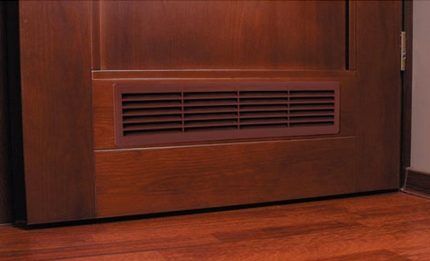
To choose the optimal device for a particular room, you should focus on the throughput of a particular system and the noise absorption coefficient. The usefulness of air exchange depends on the first parameter, the second affects the comfort of the residents of the house. And the presence of soundproofing membranes will significantly reduce the penetration of street noise into the apartment.
Installation instructions for window sill ventilation
Depending on the method chosen to create ventilation in the window sill under plastic windows, the homeowner or craftsman will have to perform certain manipulations.
Option #1 - drilling holes with grille overlay
This is the easiest and fastest way to slightly improve the circulation of warm air generated by a heating radiator.
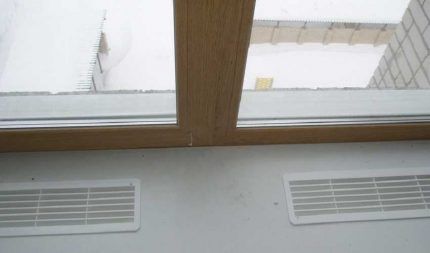
For installation you will need: a screwdriver (drill) with a drill, a pencil for marking, a ruler, an overhead grid of the required size, glue for fixing.
After preparing the necessary equipment, you need to follow a few simple steps:
- Compare the dimensions of the purchased ventilation grille and the length of the window sill to place the trim in the center, maintaining equal distances from the edges of the window sill, and make notches with a pencil.
- Attach the grille to the window sill, focusing on the marked notches, outline its perimeter.
- Inside the outlined area, make multiple holes with a drill, retreating from the pencil line by about 1-1.5 cm.
- Cover the perforated area of the window sill with a ventilation grill, securing it with glue.
In fact, all work can be completed in less than half an hour. Plastic shavings remaining after drilling can be easily removed with a vacuum cleaner.
Advantages: quick and easy implementation, minimal set of tools, simple preparation for installation. But such a grill protrudes above the level of the window sill. Also among the disadvantages is a decrease in the efficiency of the lattice cross-section.
Such measures will make it possible to slightly improve air circulation and partially solve the problem of condensate settling.
Option #2 - installing a grille with cutting a groove
This method of installing a window sill ventilation system is no more complicated than the previous one, but it allows you to more aesthetically hide an improvised ventilation duct in the thickness of the window sill if you use a built-in ventilation grille.
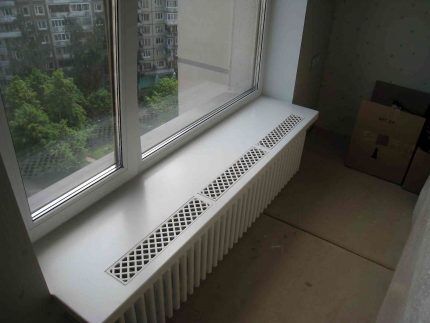
However, a similar method can also be used to install an overhead product.
In addition to the tools listed above in the description of the first method, you will also need:
- jigsaw or grinder;
- a heavy object to use as a press if the grille is fixed with glue;
- bolts, if the grille is secured with them.
After the preparatory work has been completed to mark the place where the grille will be located, you must perform the following steps:
- Drill four holes at the corner notches. The diameter of the drill bit should be larger than the width of the jigsaw cutting blade.
- Inserting the jigsaw blade into one of the resulting holes, cut out a groove.
- Insert the grate into the hole to make sure it fits properly.
- Secure the grille with glue or bolts. When using glue, use a press for better adhesion to the window sill.
If desired, you can use neither glue nor bolts. Free dismantling of the grill will greatly facilitate its care, since the product can be taken out and washed with water at any time.
Advantages of this method:
- ease of installation;
- installing the grille flush with the window sill;
- aesthetic appearance.
Disadvantages include the need for more tools and damage to the integrity of the window sill.
This window sill ventilation system looks quite aesthetically pleasing, allowing the surface to be fully used as a storage area.
Option #3 - installation of supply window sill ventilation
This is the most labor-intensive, but also the most effective way to correct air flow.
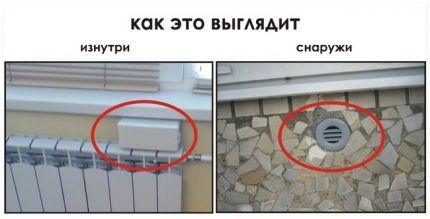
This measure allows you to fully replace heavy indoor air with fresh outdoor air and get rid of excess moisture that causes condensation to settle.
The main working tool for installation will be a hammer drill with a crown capable of making a hole in the wall of the required diameter. Check for draft in the apartment ventilation duct. If the ventilation system is working properly, proceed with installation.
Procedure:
- Select installation location. The optimal area would be between the heating radiator and the window sill itself.
- Disassemble the purchased product by disconnecting the internal unit from it. Mark the installation location, focusing on the mounting points of the box.
- Using a hammer drill, drill the exit hole for the future channel at a slight downward angle.
- Wrap the vent pipe with insulation and install it into the duct. The outer part of the device must be flush with the wall surface.
- Following the instructions for the device, install soundproofing membranes and air filters. If the valve has a fan to generate additional air flow, connect this unit to the wiring, based on the connection diagram in the passport.
- Secure the inner box with dowels.
More detailed instructions for installing a supply valve into a wall are given in next article.
The installed ventilation system requires minimal maintenance. However, the user should still clean or change the filters at least once a year so that the equipment does not lose its effectiveness.
Advantages of this option:
- the most effective method of ventilation;
- complete air exchange;
- removing excess moisture from the room.
Disadvantages include more complex installation, damage to the integrity of the wall, and higher cost of work due to the price of the valve that has to be purchased.
It is still more appropriate to entrust the selection of the supply valve and the work to a specialist. The technician will be able to accurately calculate the required equipment performance and install it correctly.
Conclusions and useful video on the topic
An experienced master shows how to install ventilation grilles in a plastic window sill:
The installation of the supply valve, performed by specialists, is discussed in detail in the video below:
A window sill ventilation system is a reliable method of eliminating unwanted condensation on plastic windows and preventing the formation of fungus and mold. You can improve air circulation in fairly simple and inexpensive ways by simply installing additional ventilation grilles in the window sill. However, if you create a new ventilation duct under the window with an effective supply valve and a heat recovery system, the replacement of heavy and humid air will take place constantly and without heat loss.
What method do you use to get rid of condensation? Tell us your story about installing ventilation in a window sill, share your experience of using such a system, take part in discussions - the contact form is located below.



